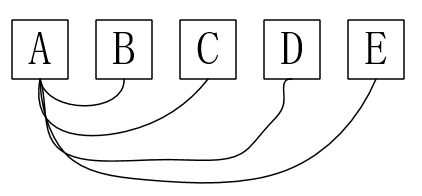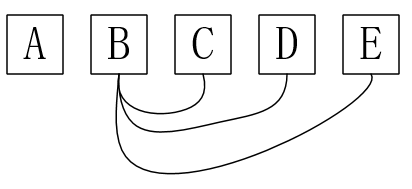2019 GDUT Rating Contest III : Problem C. Team Tic Tac Toe
题面:
C. Team Tic Tac Toe
COW
XXO
ABC
题目描述:
题目分析:
1 #include <cstdio>
2 #include <cstring>
3 #include <iostream>
4 #include <cmath>
5 #include <set>
6 #include <algorithm>
7 using namespace std;
8 char mymap[5][5];
9 char temp[5][5];
10 int vis[128][128];
11
12 bool check(char ch){
13 int flag;
14 for(int i = 0; i < 3; i++){
15 flag = 1;
16 for(int j = 0; j < 3; j++){
17 if(ch != temp[i][j]) flag = 0;
18 }
19 if(flag) return true;
20 }
21
22 for(int j = 0; j < 3; j++){
23 flag = 1;
24 for(int i = 0; i < 3; i++){
25 if(ch != temp[i][j]) flag = 0;
26 }
27 if(flag) return true;
28 }
29
30 flag = 1;
31 for(int i = 0; i < 3; i++){
32 if(temp[i][i] != ch) flag = 0;
33 }
34 if(flag) return true;
35
36 flag = 1;
37 for(int i = 0; i < 3; i++){
38 if(temp[i][2-i] != ch) flag = 0;
39 }
40 if(flag) return true;
41
42 return false;
43 }
44
45 void reback(){
46 for(int i = 0; i < 3; i++){
47 for(int j = 0; j < 3; j++){
48 temp[i][j] = mymap[i][j];
49 }
50 }
51 }
52
53 void cover(char a, char b){
54 for(int i = 0; i < 3; i++){
55 for(int j = 0; j < 3; j++){
56 if(temp[i][j] == a) temp[i][j] = b;
57 }
58 }
59 }
60
61 void test(){
62 cout <<endl;
63 for(int i = 0; i < 3; i++){
64 for(int j = 0; j < 3; j++){
65 cout << temp[i][j];
66 }
67 cout << endl;
68 }
69
70 }
71
72 int main(){
73 for(int i = 0; i < 3; i++){
74 cin >> mymap[i];
75 }
76
77 reback();
78 //test();
79
80
81 char st[15];
82 int top = 0;
83
84 int cnt1 = 0;
85 for(char i = 'A'; i <= 'Z'; i++){
86 if(check(i)) { cnt1++; st[top++] = i;}
87 }
88 cout << cnt1 << endl;
89
90 for(int i = 0; i < top; i++){
91 int u1 = st[i];
92 for(int j = 0; j < top; j++){
93 int u2 = st[j];
94 vis[u1][u2] = vis[u2][u1] = 1;
95 }
96 }
97
98 int cnt = 0;
99
100
101 for(int ai = 0; ai < 3; ai++){
102 for(int aj = 0; aj < 3; aj++){
103 char ch1 = mymap[ai][aj];
104
105 for(int bi = 0; bi < 3; bi++){
106 for(int bj = 0; bj < 3; bj++){
107 char ch2 = mymap[bi][bj];
108 reback();
109 cover(ch1, ch2);
110
111 //test();
112 if(check(ch2) && !vis[ch1][ch2]) {
113 cnt++;
114 vis[ch1][ch2] = vis[ch2][ch1] = 1;
115 }
116 }
117 }
118 }
119 }
120
121 cout << cnt << endl;
122 return 0;
123 }



1 #include <cstdio>
2 #include <cstring>
3 #include <iostream>
4 #include <cmath>
5 #include <set>
6 #include <map>
7 #include <algorithm>
8 using namespace std;
9 char g[5][5]; //图
10 int G[5][5]; //转化为整数
11 int win[30], win2[30][30]; //标记数组
12
13 void check(int a, int b, int c){
14 if(a == b && b == c) win[a] = 1; //对应一头牛“赢”的情况
15 else if(a == b && b != c) //下面两个个else if都是其中两头牛组队赢的情况
16 win2[a][c] = win2[c][a] = 1; //双向都要标记一下,去重的关键
17 else if(a == c && b != c)
18 win2[a][b] = win2[b][a] = 1;
19 else if(b == c && a != c)
20 win2[b][a] = win2[a][b] = 1;
21 }
22
23 int main(){
24 for(int i = 0; i < 3; i++) cin >> g[i];
25
26 for(int i = 0; i < 3; i++){
27 for(int j = 0; j < 3; j++){
28 G[i][j] = g[i][j]-'A'; //把字母转化为对应的数字,方便开数组
29 }
30 }
31
32 for(int i = 0; i < 3; i++){
33 check(G[i][0], G[i][1], G[i][2]); //每行
34 check(G[0][i], G[1][i], G[2][i]); //每列
35 }
36
37 check(G[0][0], G[1][1], G[2][2]); //正对角线
38 check(G[0][2], G[1][1], G[2][0]); //负对角线
39
40 int ans = 0;
41 for(int i = 0; i < 26; i++) ans += win[i]; //统计一头牛“赢”的情况
42
43 int ans2 = 0;
44 for(int i = 0; i < 26; i++){ //统计两头牛组队后“赢”的情况
45 for(int j = i+1; j < 26; j++){ //去重关键,只要遍历比i大的牛就行了
46 ans2 += win2[i][j];
47 }
48 }
49
50 cout << ans << endl << ans2 << endl;
51 return 0;
52 }
2019 GDUT Rating Contest III : Problem C. Team Tic Tac Toe的更多相关文章
- 2019 GDUT Rating Contest III : Problem D. Lemonade Line
题面: D. Lemonade Line Input file: standard input Output file: standard output Time limit: 1 second Memo ...
- 2019 GDUT Rating Contest III : Problem E. Family Tree
题面: E. Family Tree Input file: standard input Output file: standard output Time limit: 1 second Memory ...
- 2019 GDUT Rating Contest III : Problem A. Out of Sorts
题面: 传送门 A. Out of Sorts Input file: standard input Output file: standard output Time limit: 1 second M ...
- 2019 GDUT Rating Contest II : Problem F. Teleportation
题面: Problem F. Teleportation Input file: standard input Output file: standard output Time limit: 15 se ...
- 2019 GDUT Rating Contest I : Problem B. Teamwork
题面: 传送门 B. Teamwork Input file: standard input Output file: standard output Time limit: 1 second Memor ...
- 2019 GDUT Rating Contest I : Problem H. Mixing Milk
题面: H. Mixing Milk Input file: standard input Output file: standard output Time limit: 1 second Memory ...
- 2019 GDUT Rating Contest I : Problem A. The Bucket List
题面: A. The Bucket List Input file: standard input Output file: standard output Time limit: 1 second Me ...
- 2019 GDUT Rating Contest I : Problem G. Back and Forth
题面: G. Back and Forth Input file: standard input Output file: standard output Time limit: 1 second Mem ...
- 2019 GDUT Rating Contest II : Problem G. Snow Boots
题面: G. Snow Boots Input file: standard input Output file: standard output Time limit: 1 second Memory ...
随机推荐
- 转载-cookie和session的窃取
一.cookie的基本特性 如果不了解cookie,可以先到 wikipedia 上学习一下. http request 浏览器向服务器发起的每个请求都会带上cookie: GET /index.ht ...
- cs实时系统之网关设计
今天给大家讲一下client-server系统(cs)设计,基本结构 1.client 客户端,插件式开发,负责对应ui的展示 2.gateway 网关层,管理客户端通信连接,负载后端集群服务 3.s ...
- bash variables plus operator All In One
bash variables plus operator All In One Errors missing pass params #!/usr/bin/env bash # echo emoji ...
- CSS event pass through
CSS event pass through CSS 黑科技 / CSS 技巧: css 禁用点击事件, 实现事件冒泡的效果 https://caniuse.com/?search=CSS point ...
- CSS clip-path in action
CSS clip-path in action <!DOCTYPE html> <html lang="en"> <head> <meta ...
- dark theme website
dark theme website css var dark theme prefers-color-scheme https://developer.mozilla.org/en-US/docs/ ...
- clientHeight & offsetHeight & scrollHeight
clientHeight & offsetHeight & scrollHeight scrollWidth/scrollHeight,offsetWidth/offsetHeight ...
- Chrome & install App & PWA
Chrome & install App & PWA Chrome & install website as an app chrome://apps https://medi ...
- how to open a terminal in finder folder of macOS
how to open a terminal in finder folder of macOS shit service demo refs https://lifehacker.com/launc ...
- Git 学习相关笔记
Git Bash 相关命令学 基础概念 参考: https://www.cnblogs.com/gaoht/p/9087070.html https://www.runoob.com/git/git- ...
